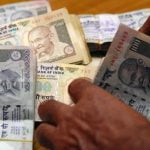
Auto drivers on strike against app-based taxi services in Delhi on Tuesday. Photo: PTI
Bengaluru: Taxi and auto-rickshaw drivers across major Indian cities from Delhi to Mumbai and Bengaluru to Kochi are taking turns to protest against what they say is a threat to their livelihoods from cab aggregators Uber and Ola. They are also demanding better rules to level what they see as an uneven playing field.
The latest protest came in the form of an indefinite strike in the country’s capital on Tuesday and Wednesday, with an estimated 90,000 auto-rickshaws and 15,000 traditional yellow top taxis stopping work, making life difficult for thousands of daily commuters—they cover shorter distances which do not have bus connectivity.
The scene was no different in the country’s financial capital Mumbai last week, when many so-called ‘kaali-peeli’ (black and yellow) taxis refused to ply in protest against cab aggregators. Black and yellow cabs are hit because in general Uber and Ola rides are far cheaper than theirs, though the app-based cab services can charge higher fares through a practice known as surge pricing.
Unlike regular cabs which have to abide by government-mandated ceilings on their minimum and maximum fares, cab aggregators are not regulated under the Motor Vehicle Act, thereby allowing them to fix those limits. Also, cab aggregators seem to carry out surge pricing almost entirely at will, despite efforts by certain states to curb the practice.
“We have some problems with Uber and Ola. They are not regulated by the transport department like we are. All black and yellow taxis in Mumbai are CNG-run by law but Uber and Ola have been given licences for diesel cabs. Why this bias?” asked Mangesh Ghadi, 40, who has been driving his taxi in Mumbai for the last 13 years.
Also read: Auto, taxi strike continues in Delhi; Kejriwal attacks Jung, BJP
Like many other traditional taxi cab drivers, Ghadi complained about a hit to his income from Uber and Ola.
Ola operates in 102 cities, while Uber runs in 27. Both of them get about 90% of their business from the top 8 to 10 cities, the top three being Bengaluru, Mumbai and Delhi.
“Six months back I used to earn Rs.1700-1800 per day. I am barely making a thousand rupees now. It is difficult to run family after deducting expenses for CNG and maintenance,” Ghadi lamented.
Uber asked for more time on Wednesday to respond toMint’s specific queries on how it plans to deal with the rising resistance. Ola did not respond to requests seeking comment.
Many other drivers of traditional taxis have also asked lawmakers to look into complaints about passenger safety while using Uber and Ola cabs and other discriminatory practices such as the fact that Uber and Ola drivers are not mandated to wear uniforms like many of the regular taxi drivers.
In some ways, the protests seem to be an instance of old economy stakeholders trying to fend off disruption from tech-savvy start-ups. The emergence of app-based cab services is closely linked with the rise of mobile phone users in India.
While similar protests against Uber by taxi unions in cities such as London and New York have had little impact, lawmakers in India may be forced to take at least baby steps to tackle the issue, considering the disruption to daily life and the rising popularity of cab aggregator services in many tier 1 and tier 2 Indian cities.
Governments across the day have traditionally pandered to taxi, and especially auto, operators in India for a variety of reasons including vote bank politics. This regulated everything from number of taxi and auto permits to pricing. That’s been disrupted now.
Lawmakers now have a delicate task at hand: They have to give commuters more options, be fair to traditional players and new entrants, and at the same time come up with newer and smarter ways to regulate a burgeoning industry.
“Nobody thought business will be carried out this way,” said Sandeep Ladda, a partner and national leader of the technology & e-commerce sector practice at PwC India.
“They are facing such challenges not only in India, but some other parts of the world. That is also because the way this business model works is not the way the taxi industry used to work 20-30 years ago.”
Maharashtra is planning to bring cab aggregators under the Motor Vehicle Act and under the purview of a new City Taxi Scheme aimed at regulating the operations of cab aggregators by fixing their minimum and maximum fare. The scheme has been approved by the transport department and is awaiting clearance from chief minister Devendra Fadnavis, Maharashtra transport minister Diwakar Raote said.
Officials in the Delhi government say that the mobile-based taxi services are illegal as they don’t have the required permissions from the Delhi transport department. The Aam Aadmi Party (AAP) led Delhi government has written to the central government to block the apps of these taxi aggregators.
“The strike is politically motivated and sponsored by the opposition. We have already written to the Delhi police regarding this. There is only a small (2-4) percentage who want to go on strike, the rest are against it. It is because of fear that they are not able to ply. It is in the hands of the central government to stop the cabs,” Delhi transport minister Satyendar Jain said.
The Delhi government alleged that it is due to political pressure that autos are not being allowed to ply on the roads. Some auto drivers on the streets on the second day of the strike on Wednesday also complained that they were being coerced to take part. An auto driver in Mayur Vihar locality in east Delhi said not complying meant risking his vehicle being vandalized while supporting meant loss of income.
The Delhi government has been looking to crack down on mobile-based taxi aggregators for surge pricing. In April, during the second round of the odd-even scheme, the government impounded cabs of Ola and Uber for charging higher fares. To keep a check on the companies, the government also plans to introduce a policy under which app-based cab companies will have to charge fares set by the state transport department. The details of the policy are being worked out.
In Karnataka, the matter is in the courts after Uber filed a petition challenging the competence of the state government to enforce rules on cab aggregators.
“We are not opposed to app based cab aggregators. But they are expected to follow the law made by the state. If only bookings are done by app, it is fine. But cash transactions, billing, driver verification and incentives are all done through the app. This makes every driver a proper business man and mandates him to carry a trade certificate,” said Radhakrishna Holla, president, Bangalore Tourist Taxi Owners Association.
The new government in Kerala has come up with a draft policy to regulate cab aggregators, looking to define a cab aggregator better and making sure only entities registered under certain rules (the 1956 Companies Act and complies with regulations under the Information Technology Act 2000) are allowed to obtain a licence for a three-year period.
To be sure, there are also many taxi drivers who moved from traditional fleets to work for Ola and Uber, citing fewer middlemen, higher incomes and the ability to own their cars.
“With Ola/Uber, we have become owners. Earlier, we could never think of owning the car we drive. Now we are all owners and earn almost Rs.5000 a day. The payment also comes on a regular basis,” said Prasanna Kumar KP, an Uber/Ola driver in Bengaluru.
Abhiram Ghadyalpatil in Mumbai, Pretika Khanna from Delhi, Sayan Chakraborty, Sharan Poovanna and Nidheesh MK in Bengaluru contriburted to this story.
[“Source-Livemint”]




